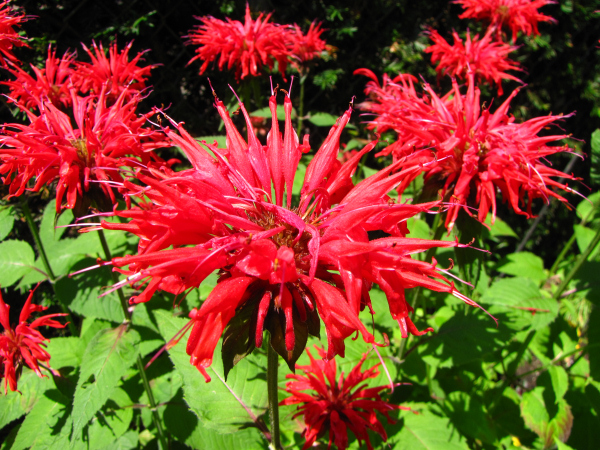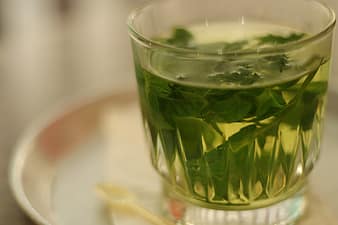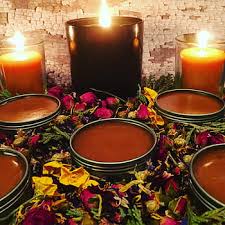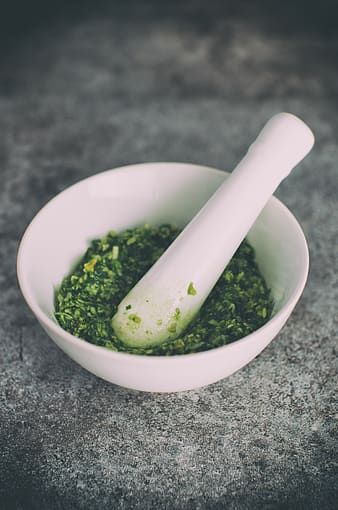Bee balm is the common name of the plants of the Monarda genus, a native plant to North America. The most common species in the Pennsylvania area include Monarda didyma and Monarda fistulosa. These herbs are members of the mint family Lamiaceae, causing the leaves of the bee balm plant to have a slightly sweet, minty flavor. The bee balm plant stands between 2.5 and 4 feet tall with pointed leaves emerging in pairs from the stem, and ends in a blossom during the summer months.
The brightly colored flowers that top these herbal plants are usually crimson or lavender (M. didyma and M. fistulosa, respectively), but can appear in bright pink and white as well (a hybrid variety and M. clinopodia, respectively). The flowers have thin, tubular petals arranged in an open pattern to form a shaggy sphere, and also have a sweet taste. The plant will begin to bloom in July and continue through late September. Bee balm seeds can be collected from the matured flowers 1-3 weeks after they first bloom, and these small, brown seeds can be used for propagation.
Bee balm attracts native pollinators including bees, butterflies, and even hummingbirds! It is a particularly important nutrient source for Monarch butterflies, and also draws bumblebees and other native bees, such as sweat bees, digger bees, large carpenter bees, leaf-cutter bees, long-horned bees, mason bees, and small carpenter bees. In addition to its aesthetic beauty and pollinator support, bee balm has many useful herbal properties.

Uses
NOTE: Please read our full disclaimer at the end of this article before harvesting or consuming Beebalm.
Bee balm has been used by the Native American community, particularly the Oswego and Oneida Nations, and others for centuries as an herbal remedy to many ailments. According to the Fish and Wildlife Service, the Oneida Nation, recognizing its use as an antiseptic, used bee balm teas to soothe fevers, headaches, and stomachaches. Culturally, the Oneida Nation considers bee balm to be the sixth medicine supplied to people by the Creator and so call it “Number Six.”
European colonists also made teas from bee balm, after being taught its properties by the Oswego people. It is said that this tea was what many European colonists drank as a replacement during the tea boycott after the Boston Tea Party.
The main herbal properties of bee balm stem from its antimicrobial effects. All parts of the plant are especially adept at treating digestive issues as the plant has carminative properties that combat a buildup of gas in the body. Additionally, the plant acts as a diuretic which can also help to soothe digestive problems. Bee balm is also a febrifuge, leading to its use in fever reduction.
Here are a few ways and recipes to make use of bee balm’s properties:

- Bee Balm Tea
Harvest bee balm leaves and flowers spring – summer for an aromatic cup of hot or cold infused tea! Photo credit: tps://advicefromtheherblady.com/growing-herb-blends/grow-your-own-herbal-tea/
Bee balm tea is one of the simplest ways to use bee balm. After snipping the fully-bloomed flowers off of the plant, carefully pull each petal off of the flower center. They should pull away fairly easily. Then, add about 2 tablespoons of the fresh flowers to a cup of recently boiled water. If the water is too hot the flowers will lose some of their flavor. Steep for 15 minutes and enjoy! As mentioned above, this tea has numerous healing properties, but will be most helpful in treating digestive issues or fevers.
Recipe site here

2. Bee Balm Salve
Making a bee balm salve is a way to capture the antimicrobial properties of bee balm in a way that can be conveniently used on scraped, irritated, or itchy skin. To make a salve, first infuse a carrier oil such as olive oil or almond oil with the bee balm by mixing equal weights dried bee balm petals with the oil of choice. Let the oil infuse for as little as a week up to a month in a warm place. Then strain the oil to remove the petals. Finally, heat the oil and add 1 oz. of beeswax per 8 oz. of infused oil and allow to melt together. Once combined, allow to cool completely before use.
Recipe site here

3. Bee Balm Pesto
Although bee balm flowers have many uses, the leaves can also be used as a flavor addition to many common recipes. For bee balm pesto, add a few fresh bee balm leaves to a combination of basil, parsley, oregano, mint, or lemon flavored herbs along with some garlic, olive oil, and walnuts for a flavorful pesto that will go great with pasta, meat, or salad!
In addition to these fun uses, both the flowers and the leaves of bee balm can also be simply added as flavorful, herbal additions to salads, soups, and other culinary projects!
Propagation/Cultivation
Bee balm is a perennial herb, which means that once planted, it should come back each spring even as the above ground growth dies back during the winter. The initial planting can be in mid-spring or early fall. Bee balm can be propagated from seed, and these seeds can be harvested from existing plants. To collect the seeds, wait 1-3 weeks after the flowers bloom. Then, check for seeds by gently shaking the bloom over a container to catch the seeds. If none fall out, wait an additional week before checking again. Once harvested, dry the seeds on a paper towel for 2-3 days, and then store in a container until ready to plant. Seeds should be sown in early spring, and covered very lightly with soil. The soil should be kept moist throughout the growing season.
When decided where to plant bee balm, make sure to consider that bee balm enjoys full sun as well as rich soil. However, bee balm will grow fairly well in less-than ideal conditions, including part shade. This plant can get to be fairly tall (2-4 feet) and individual plants should be planted 18-24 inches apart from each other to allow room for growth.
Bee balm is also an ideal candidate for companion planting with fruit trees and other garden plants. Bee balm is especially useful on orchard floors, as it is capable of thriving in partial sunlight and can act as a strong bird attractor for pollinating the fruit trees planted nearby. In the same way, bee balm is beneficial for vegetable gardens as it attracts important bees. Additionally, bee balm can act as a pest confuser. A pest confuser is an herb with a strong smell that, when planted near other vegetable plants, makes it difficult for pests or insects to locate the vulnerable plant.
During the first season after planting, keep the surrounding soil damp by watering frequently and mulch the area if desired. However, if you see powdery mildew developing on the plant, reduce watering as this disease is usually a product of too much moisture around the plant. To treat existing powdery mildew combine 1 tablespoon baking powder, 1 teaspoon light horticultural oil, and 1 gallon of water to spray on the plant once a week.
When the bee balm plant is flowering, remove the dead flowers after they bloom so that the plant can continue growing through the summer season. Additionally, using the flowers in any of the ways described above helps keep the plant healthy as it removes the flowers before they die and become a burden to the plant.
After the growing season, snip the flower stalks off to a few inches above the ground for the winter. Again, the plant may die back to the ground over the winter months, but it should return in the spring.
Hopefully this guide to caring for and using bee balm was helpful! Bee balm’s use as both an attractor for native pollinators and as an herb makes it both a useful and beautiful addition to any garden or orchard floor.
Sources:
https://www.gardeningknowhow.com/ornamental/flowers/bee-balm/bee-balm-care.htm
https://www.healthline.com/health/diy-herbal-salves#diy-herbal-salve
https://www.almanac.com/plant/bee-balm
https://www.melindamyers.com/articles/powdery-mildew-on-bee-balm
https://www.fws.gov/midwest/news/OneidaRestoration.html
https://pfaf.org/user/Plant.aspx?LatinName=Monarda+didyma
https://blog.gardeningknowhow.com/tbt/history-bee-balm/
Disclaimer
The Philadelphia Orchard Project stresses that you should not consume parts of any wild edible plants, herbs, weeds, trees, or bushes until you have verified with your health professional that they are safe for you. As with any new foods that you wish to try, it is best to introduce them slowly into your diet in small amounts.
The information presented on this website is for informational, reference, and educational purposes only and should not be interpreted as a substitute for diagnosis and treatment by a health care professional. Always consult a health care professional or medical doctor when suffering from any health ailment, disease, illness, or injury, or before attempting any traditional or folk remedies. Keep all plants away from children. As with any natural product, they can be toxic if misused.
To the best of our knowledge, the information contained herein is accurate and we have endeavored to provide sources for any borrowed material. Any testimonials on this web site are based on individual results and do not constitute a warranty of safety or guarantee that you will achieve the same results.
Neither the Philadelphia Orchard Project nor its employees, volunteers, or website contributors may be held liable or responsible for any allergy, illness, or injurious effect that any person or animal may suffer as a result of reliance on the information contained on this website nor as a result of the ingestion or use of any of the plants mentioned herein.
SAFETY PRECAUTION: While there are many plants which are helpful and beneficial for us to partner with, there are plants that are dangerous for us to consume or even to touch. It’s important that we take the necessary precautions – in a city space: avoid harvesting from places with pollution or runoff; avoid harvesting endangered plants; understand there are some plants used medicinally only in small doses vs some that can be eaten with relatively little concern. The most important thing is that you trust your body, go slow with incorporating any new plants into your diet!
This POP Blog Post was written by POP Education Intern Bethany Bronkema.
SUPPORT US! If you found this entry useful, informative, or inspiring, please consider a donation of any size to help POP in planting and supporting community orchards in Philadelphia: phillyorchards.org/donate.